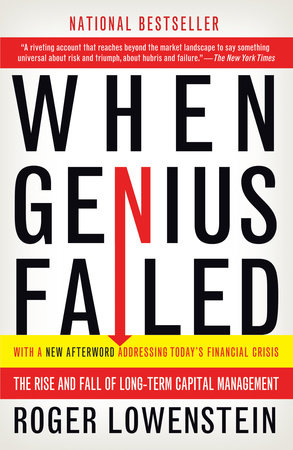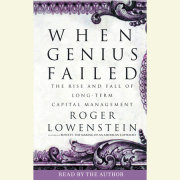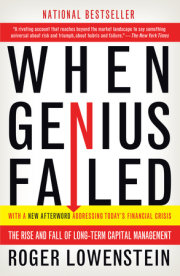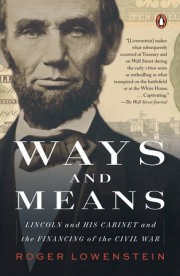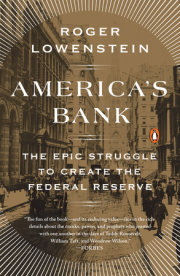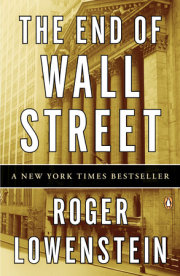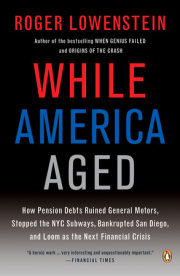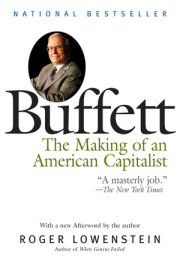IntroductionThe Federal Reserve Bank of New York is perched in a gray, sandstone slab in the heart of Wall Street. Though a city landmark building constructed in 1924, the bank is a muted, almost unseen presence among its lively, entrepreneurial neighbors. The area is dotted with discount stores and luncheonettes-and, almost everywhere, brokerage firms and banks. The Fed's immediate neighbors include a shoe repair stand and a teriyaki house, and also Chase Manhattan Bank; J. P. Morgan is a few blocks away. A bit further, to the west, Merrill Lynch, the people's brokerage, gazes at the Hudson River, across which lie the rest of America and most of Merrill's customers. The bank skyscrapers project an open, accommodative air, but the Fed building, a Florentine Renaissance showpiece, is distinctly forbidding. Its arched windows are encased in metal grille, and its main entrance, on Liberty Street, is guarded by a row of black cast-iron sentries.
The New York Fed is only a spoke, though the most important spoke, in the U.S. Federal Reserve System, America's central bank. Because of the New York Fed's proximity to Wall Street, it acts as the eyes and ears into markets for the bank's governing board, in Washington, which is run by the oracular Alan Greenspan. William McDonough, the beefy president of the New York Fed, talks to bankers and traders often. McDonough especially wants to hear about anything that might upset markets or, in the extreme, the financial system. But McDonough tries to stay in the background. The Fed has always been a controversial regulator-a servant of the people that is elbow to elbow with Wall Street, a cloistered agency amid the democratic chaos of markets. For McDonough to intervene, even in a small way, would take a crisis, perhaps a war. And in the first days of the autumn of 1998, McDonough did intervene-and not in a small way.
The source of the trouble seemed so small, so laughably remote, as to be insignificant. But isn't it always that way? A load of tea is dumped into a harbor, an archduke is shot, and suddenly a tinderbox is lit, a crisis erupts, and the world is different. In this case, the shot was Long-Term Capital Management, a private investment partnership with its headquarters in Greenwich, Connecticut a posh suburb some forty miles from Wall Street. LTCM managed money for only one hundred investors, it employed not quite two hundred people, and surely not one American in a hundred had ever heard of it. Indeed, five years earlier, LTCM had not even existed.
But on the Wednesday afternoon of September 2-3, 1998, Long-Term did not seem small. On account of a crisis at LTCM, McDonough had summoned-- invited," in the Fed's restrained idiom-the heads of every major Wall Street bank. For the first time, the chiefs of Bankers Trust, Bear Stearns, Chase Manhattan, Goldman Sachs, J.P. Morgan, Lehman Brothers, Merrill Lynch, Morgan Stanley Dean Witter, and Salomon Smith Barney gathered under the oil portraits in the Fed's tenth-floor boardroom-not to bail out a Latin American nation but to consider a rescue of one of their own. The chairman of the New York Stock Exchange joined them, as did representatives from major European banks. Unaccustomed to hosting such a large gathering, the Fed did not have enough leather-backed chairs to go around, so the chief executives had to squeeze into folding metal seats.
Although McDonough was a public official, the meeting was secret. As far as the public knew, America was in the salad days of one of history's great bull markets, although recently, as in many previous autumns, it had seen some backsliding. Since mid-August, when Russia had defaulted on its ruble debt, the global bond markets in particular had been highly unsettled. But that wasn't why McDonough had called the bankers.
Long-Term, a bond-trading firm, was on the brink of failing. The fund was run by, John W. Meriwether, formerly a well-known trader at Salomon Brothers. Meriwether, a congenial though cautious midwesterner, had been popular among the bankers. It was because of him, mainly, that the bankers had agreed to give financing to Long Term-and had agreed on highly generous terms. But Meriwether was only the public face of Long-Term. The heart of the fund was a group of brainy, Ph.D.-certified arbitrageurs. Many of them had been professors. Two had won the Nobel Prize. All of them were very smart. And they knew they were very smart.
For four years, Long-Term had been the envy of Wall Street. The fund had racked up returns of more than 40 percent a year, with no losing stretches, no volatility, seemingly no risk at all. Its intellectual supermen had apparently been able to reduce an uncertain world to rigorous, cold-blooded odds-they were the very best that modern finance had to offer.
Incredibly, this obscure arbitrage fund had amassed an amazing $100 billion in assets, all of it borrowed-borrowed, that is, from the bankers at McDonough's table. As monstrous as this leverage was, It was by no means the worst of Long-Term's problems. The fund had entered into thousands of derivative contracts, which had endlessly intertwined it with every bank on Wall Street. These contracts, essentially side bets on market prices, covered an astronomical sum-more than $1 trillion worth of exposure.
If Long-Term defaulted, all of the banks in the room would be left holding one side of a contract for which the other side no longer existed. In other words, they would be exposed to tremendous-and untenable-risks. Undoubtedly, there would be a frenzy as every bank rushed to escape its now one-sided obligations and tried to sell its collateral from Long-Term.
Panics are as old as markets, but derivatives were relatively new. Regulators had worried about the potential risks of these inventive new securities, which linked the country's financial institutions in a complex chain of reciprocal obligations. Officials had wondered what would happen if one big link in the chain should fall. McDonough feared that the markets would stop working, that trading would cease; that the system itself would come crashing down.
James Cayne, the cigar-chomping chief executive of Bear Stearns, had been vowing that he would stop clearing Long-Term's trades which would put it out of business-if the fund's available assets fell below $500 million. At the start of the year, that would have seemed remote, for Long-Term's capital had been $4.7
billion. But during the past five weeks, or since Russia's default, Long-Term had suffered numbing losses-day after day after day. Its capital was down to the minimum. Cayne didn't think it would survive another day.
The fund had already gone to Warren Buffett for money. It had gone to George Soros. It had gone to Merrill Lynch. One by one, it had asked every bank it could think of. Now it had no place left to go. That was why, like a godfather summoning rival and potentially warring- families, McDonough had invited the bankers. If each one moved to unload bonds individually, the result could be a worldwide panic. If they acted in concert, perhaps a catastrophe could be avoided. Although McDonough didn't say so, he wanted the banks to invest $4 billion and rescue the fund. He wanted them to do it right then-tomorrow would be too late.
But the bankers felt that Long-Term had already caused them more than enough trouble. Long-Term's secretive, close-knit mathematicians had treated everyone else on Wall Street with utter disdain. Merrill Lynch, the firm that had brought Long-Term into being, had long tried to establish a profitable, mutually rewarding relationship with the fund. So had many other banks. But Long-Term had spurned them. The professors had been willing to trade on their terms and only on theirs-not to meet the banks halfway. The bankers did not like it that now Long-Term was pleading for their help.
And the bankers themselves were hurting from the turmoil that Long-Term had helped to unleash. Goldman Sach's CEO, Jon Corzine, was facing a revolt by his partners, who were horrified by Goldman's recent trading losses and who, unlike Corzine, did not want to use their diminishing capital to help a competitor. Sanford I. Weill, chairman of TravelersSalomon Smith Barney, had suffered big losses, too. Weill was worried that the losses would jeopardize his company's pending merger with Citicorp, which Weill saw as the crowning gem to his lustrous career. He had recently shuttered his own arbitrage unit-which, years earlier, had been the launching pad for Meriwether's career-and did not want to bail out another one.
As McDonough looked around the table, every one of his guests was in greater or lesser trouble, many of them directly on account of Long-Term. The value of the bankers' stocks had fallen precipitously. The bankers were afraid, as was McDonough, that the global storm that had begun so innocently with devaluations in Asia, and had spread to Russia, Brazil, and now to Long-Term Capital, would envelop all of Wall Street.
Richard Fuld, chairman of Lehman Brothers, was fighting off rumors that
his company was on the verge of failing due to its supposed overexposure to Long-Term. David Solo, who represented the giant Swiss bank Union Bank of Switzerland (UBS), thought his bank was already in far too deeply, it had foolishly invested in Long-Term and had suffered titanic losses. Thomas Labrecque's Chase Manhattan had sponsored a loan to the hedge fund of $500 million; before Labrecque thought about investing more, he wanted that loan repaid.
David Komansky, the portly Merrill chairman, was worried most of all. In a matter of two months, the value of Merrill's stock had fallen by half-$19 billion of its market value had simply melted away. Merrill had suffered shocking bond-trading losses, too. Now its own credit rating was at risk.
Komansky, who personally had invested almost $1 million in the fund, was terrified of the chaos that would result if Long-Term collapsed. But he knew how much antipathy there was in the room toward Long-Term. He thought the odds of getting the bankers to agree were a long shot at best.
Komansky recognized that Cayne, the maverick Bear Stearns chairman, would be a pivotal player. Bear, which cleared Long-Term's trades, knew the guts of the hedge fund better than any other firm. As the other bankers nervously shifted in their seats, Herbert Allison, Komansky's number two, asked Cayne where he stood.
Cayne stated his position clearly: Bear Stearns would not invest a nickel in Long-Term Capital.
For a moment the bankers, the cream of Wall Street, were silent. And then the room exploded.
. All rights reserved. No part of this excerpt may be reproduced or reprinted without permission in writing from the publisher.

